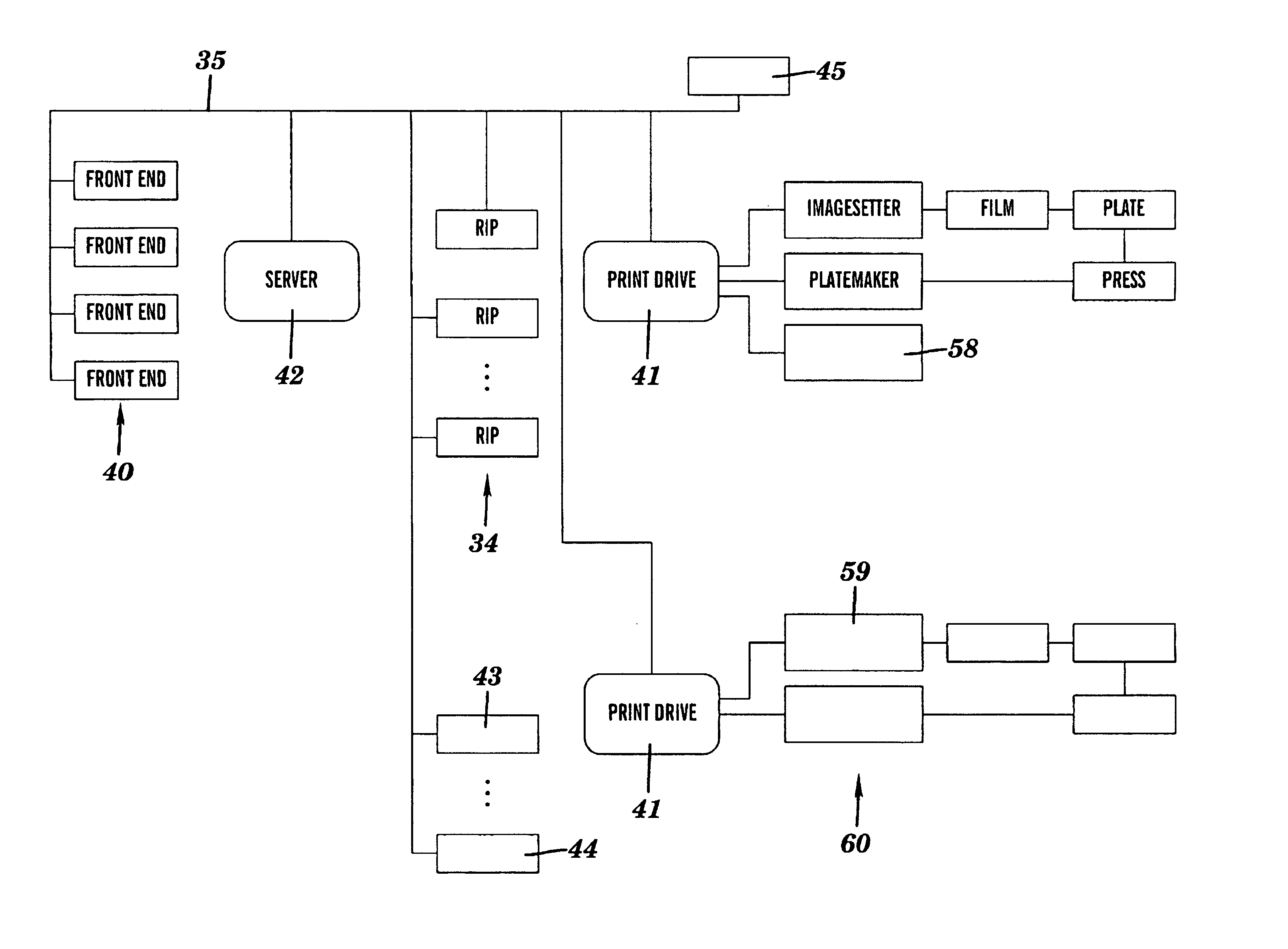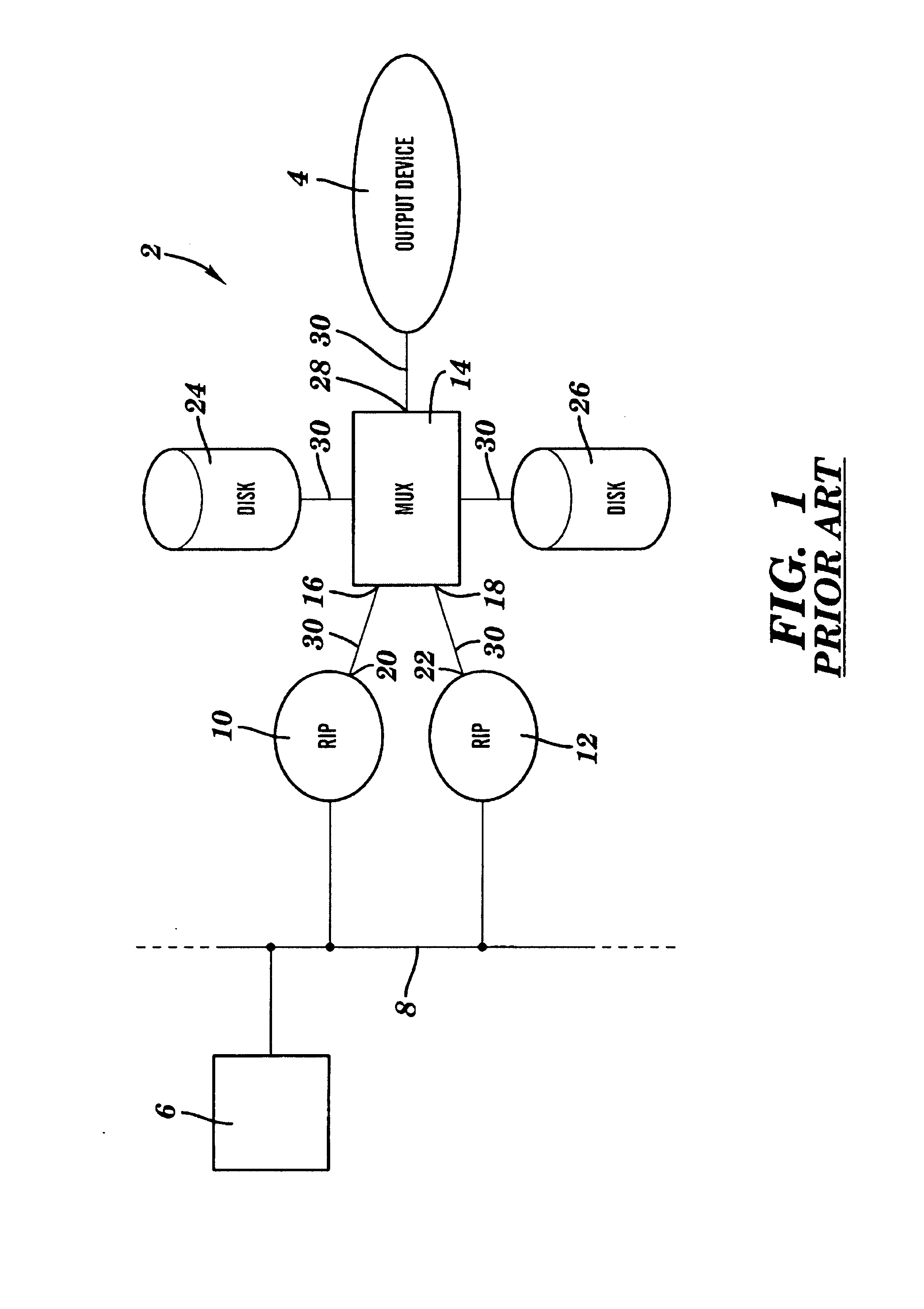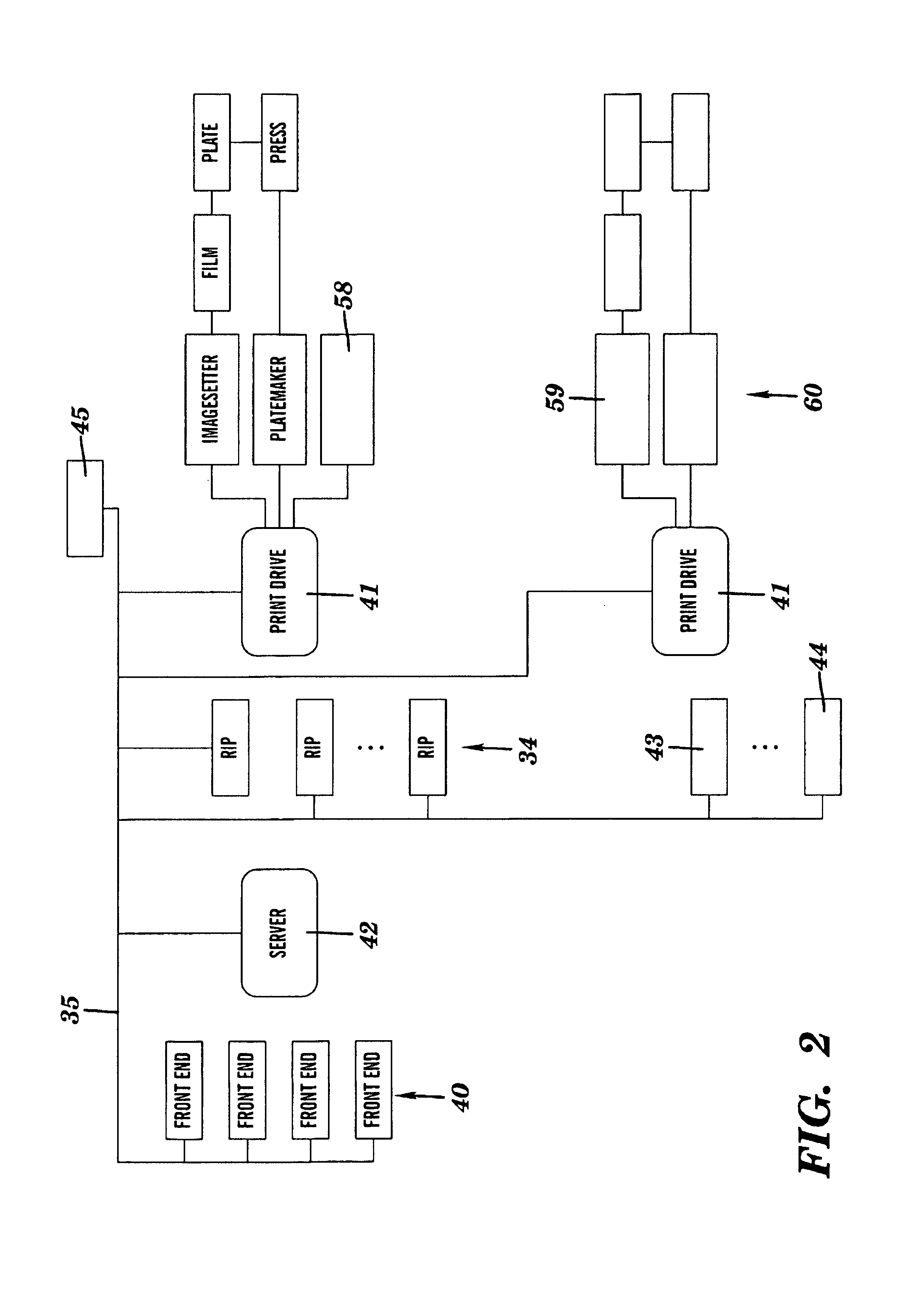[0002]More particularly still, the present invention is directed to a system for the inputting, tracking, processing, queuing, storing, editing and printing of raster or bit map data, and to a method for providing a nearly continuous output of raster images to a plurality of output devices, such as, imagesetters, platemakers, on-press imagers, digital proofers, digital color printers and the like. Of course, as should be apparent from the following discussion, any application involving the
multiplexing of large parcels of data could take
advantage of the present invention.
[0003]DEFINITIONSALDCIBM compression / decompression chipAgfa Print EngineAn Agfa proprietary point to point dataInterfacetransmission protocol consisting of aSpecification,serial bi-directional command channel(APIS).(APIS serial) and a parallel uni-directional
data channel (APIS video)BackupAn operation to temporarily save a job ina dedicated
backup area.CDFComponent Description File, A file whichcontains
text string conversions forinternationalization.Device APIGeneric Application
Programming Interfacefor connecting AGFA devices.EDFEngine Description File. These filesprovide a way to set PostScript printerspecific features on a more global basis.They differ from PPD choices in that theyare persistent for each RIP Bootup andmore commonly used to
handle default settings.EngineA hardware device capable of receivingand printing
Raster data on film or othermedia. (For example, Agfa's Avantrafamily of Engines) (Output printing device)ExportThis refers to the operation of providinglong-term off-line storage of jobs, orthe ability to send jobs to a remote site.
Fast Ethernet (100Communication medium, 100 Mb / sec maxi-BaseT)mum transfers over
Twisted pair wire.Fast Wide
SCSI16 bits wide and 20 MB / sec maximumtransfer rate.ImportThis refers to the operation of bringinga job into the PowerMux system from anexternal media source.JobOne or more related pages togetherconstitute a job. This is thesmallest entity that can be manipulatedby the PowerMux.Job ListTerminology for the
list of jobs, thatare available for imaging.Job StateCurrent read-only State of a Job. (E.g.,Hold, Imaging,
Spooling, etc.)MUXMultiplexerNull Device DriverA “dummy” device that adheres to theDevice API. All data sent to this devicedriver is essentially dropped on thefloor, that is there is no interpretationor saving of data.PageOne or more related separations togetherconstitute a “page”. For example, “thecyan,
magenta, yellow, and blackseparations for page 3”.PPD FileA PostScript Printer Description file. Ahuman readable
text file that can beparsed and provides a uniform approach tohandling special features of devices thatcontain PostScript interpreters. Theseare applied on a job by job basis.PSEPostScript Environment layer of softwarewith interfaces to front-end PostScriptprograms and Agfa's RIPs.SeparationA single 1-bit Raster image as outputfrom a RIP. For example, “the cyanseparation”. This is also referred to asa “take”.TakeSee Separation.SpindleChoice of media holding device for usePRINTon an engineCommand user inputs into a front endterminal after completing a documentwhich signals the beginning of a print job.
MULTIPLEXER (MUX,Prior art device driver capable ofMUX CONTROLLER)receiving raster data from as many astwo RIPs, basic
advantage-bufferPRINT DRIVERDevice and raster image manager for(a.k.a., Printdriveproviding efficient
throughput due toor PrintDrive)buffering of output files. (See alsoMultiplexer).RIPRaster Image ProcessorFLATOne or more separations of like colorformatted for printingFRONT END USERGraphic arts designerPRINT DRIVEWorkflow administrators for settingOPERATORpriority of output high speed networksuch as 100 BASE-TPAST ETHERNETHigh speed network such as 100 BASE-TCMYKCyan,
Magenta, Yellow, BlackBACKGROUND
[0004]As known in the art of imagesetting and electronic prepress systems, heretofore, output devices, e.g. imagesetters and more recently platesetters typically have been served by a dedicated
Raster Image Processor (RIP) connected between a front-end and an
output device. Typical electronic prepress image file sizes, e.g. often greater than 100 Megabytes per page, have previously restricted electronic prepress systems to dedicated proprietary hardware and
software systems using parallel data transfer methods to provide high speed data transfer rates between the front-end, the RIP and the
output device[0005]More recently, use of page description languages, e.g. Postscript™ and PDF™, offered by
Adobe Systems of Mountainview Calif., have allowed object oriented text descriptions of large image data files to be transferred efficiently over serial data communication lines, as used in network systems and adopted in electronic prepress systems, for transferring serial image data in page description formats between a front-end and a RIP. Serial data transfer systems offer the
advantage that two way communications between the front-end and the RIP allow status information and other commands and files to be transferred in either direction as will be further described below.
[0006]Once the image file data is received by the RIP, operations such as image screening, color separating, imposition,
trapping and various other prepress image preparation operations result in a final bit map image
data file which heretofore has been transferred to the
output device over a parallel data transfer interface in order to provide an efficient data transfer rate, thereby, keeping the output device operating at a desired
operating speed. Typically, the process of RIPing data, i.e. preparing a final bit map image file for transfer to the output device, has been slow, sometimes causing the output device to remain idle while waiting for a RIP to prepare the next bit map image file.
[0007]Even more recently, the use of a RIP
multiplexer, (MUX), e.g. MULTISTAR, offered by Agfa Corporation of Wilmington,
Mass., has offered the electronic prepress industry some improvement in data
throughput, and
cost savings, by functioning as a page buffer between one or two RIPs, and a single output printing device.
Cost savings and improved efficiency have been realized by either RIPing an image with a first RIP while transferring a previously RIPed image to the output device or by storing RIPed image data for transfer to the output device at an appropriate time after RIPing. This more fully utilizes the output device, or print engine, which is typically an expensive resource. In fact, keeping the print engine busy is a key design goal of any electronic prepress system design.
 Login to View More
Login to View More  Login to View More
Login to View More 


